Today's Grand Challenges in higher education need to be met with a new approach: a Grand Strategy that utilizes the cultural, workforce, and technological shifts of digital transformation.

"'We're in a fix and no mistake,' said Sam Gamgee. He stood despondently with hunched shoulders beside Frodo, and peered out with puckered eyes into the gloom."1 Sam and Frodo Baggins, two hobbits from the pastoral Shire, found themselves alone, ill-equipped, in a hostile and unfamiliar landscape, knowing that the best path to completing their quest lay ahead through that very gloom. The stakes were high: the very future of Middle Earth.
Sound familiar? You've almost certainly heard or expressed this sentiment recently, as those working in colleges and universities peer out into the gloom ahead, trying to find the best path forward yet knowing that all the territory ahead is new and uncertain and that they are surrounded by obstacles they've never encountered before. Just like Frodo and Sam, higher education leaders can't be certain whether a new situation constitutes an opportunity (a possible supplier/partner) or a threat (a possible competitor). Just as for Frodo and Sam, the stakes are extraordinarily high: the continued existence of individual institutions and the very future of higher education.
Today's challenges, unprecedented in scope and number, demand a new plan. We propose a different approach, a way for higher education leaders to reframe the work ahead and to judiciously consider how technology can be most helpful. First, leaders should think about their institutional strategic priorities as a set of Grand Challenges: challenges that are as important as they are difficult and that pertain specifically to the institution as well as more broadly to the higher education ecosystem. Next, leaders should adopt a Grand Strategy, which can provide a cohesive principle and vision to help them consider their resources holistically and focus on their most consequential priorities. Finally, leaders should take into account digital transformation (Dx), which can advance this Grand Strategy by reinventing institutional culture, modernizing workforce practices, and applying new technologies to the missions and management of higher education.
Higher Education's Grand Challenges
The term Grand Challenges comes to us from another, more hopeful and expansive time. Originally it was used to justify and guide major policy-driven investments in STEM areas in the 20th century. For example, in the late 1980s the US Office of Science and Technology Policy provided funding for "Grand Challenges in Computing" to stimulate the development of applications of high-performance computing in order to increase the competitive advantage of the United States against such advanced nations as Japan.2 The term has been used in many fields, including energy sciences, engineering, social work, and global health.
A Grand Challenge describes desired outcomes to problems that are extremely difficult (but not impossible) to solve and that are widespread, if not global, in scope. A Grand Challenge is meant to inspire policy makers, funders, the public, and the media to create and amplify an urgent commitment to achieve and accelerate progress. A Grand Challenge may be tackled by individual organizations, but it also has a community component. Because Grand Challenges are complex, they generally involve ongoing experimentation and learning. Communities can collectively develop a sense of what is possible and where the risks lie.
This is not the first time the term Grand Challenges has been applied to higher education. Almost fifteen years ago, at the 2006 EDUCAUSE Annual Conference, EDUCAUSE President Brian Hawkins described three Grand Challenges: affordability, access, and accountability. Freeman Hrabowski, president of the University of Maryland, Baltimore County, wrote a follow-up column in EDUCAUSE Review to share his perspective on how technology could address access and accountability, and he added another Grand Challenge to the list: assessment.3
In 2020 we are again applying the concept of Grand Challenges to four of the most consequential and widespread concerns facing higher education today: student success, financial health, reputation and relevance, and external competition. Each Grand Challenge encompasses several issues that institutions are struggling to address (see figure 1). EDUCAUSE staff identified these four Grand Challenges and related issues after interviewing more than forty college and university presidents, provosts, chief business officers, and other institutional leaders in 2019 and 2020.4
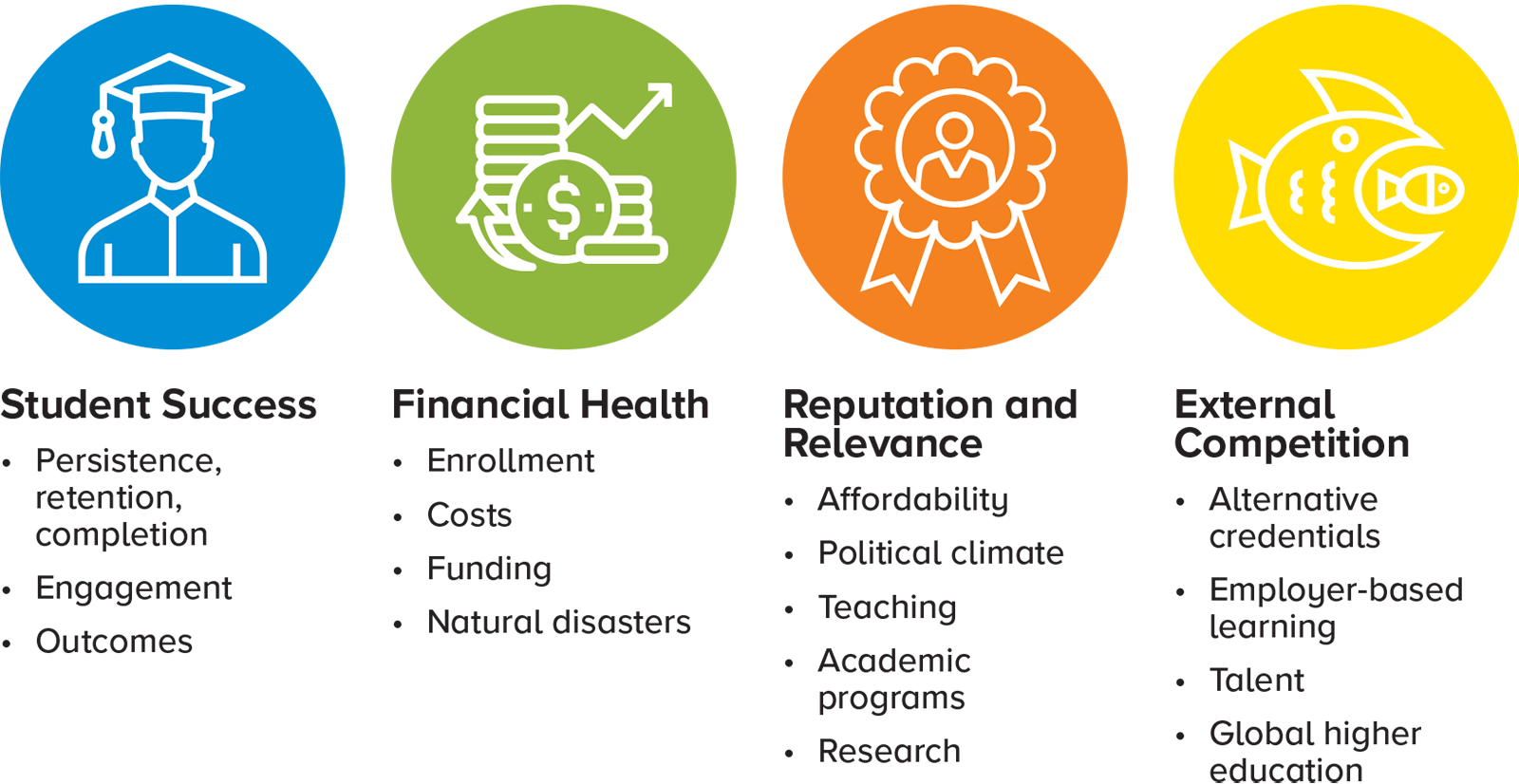
Student Success. The challenge of student success pertains to meeting such key performance indicators as student persistence (remaining at the institution), retention (completing a course), and completion (attaining a credential). Engagement and outcomes are two additional student success issues. Engagement involves helping students build a rich learning and social experience during their academic years so that they get the most out of their education. Outcomes can be intangible (e.g., expanded horizons), although students and policy makers are increasingly focused on concrete outcomes such as a good job, a useful credential, and low debt.
Financial Health. When campus leaders we interviewed spoke of financial health, they described challenges related to income and expenses. In the United States, many institutions have been troubled by decreasing enrollment levels (usually due to demographic drops in the number of college-age students), which make it very difficult to budget for and meet ongoing operational costs. Another stressor on income is an institution's funding model. Publicly funded institutions, in particular, have had to absorb ongoing cuts in funding from state governments. The average US research university received about 33 percent of its funding from the state government in 2012, down from 53 percent in 1987.5 Endowment income has helped many institutions fund a proportion of their operations, but the major market crashes triggered by the COVID-19 pandemic are reducing that source of income just when enrollments declines for Fall 2020 are anticipated. Even before the pandemic, several leaders we spoke with worried about the disruption of their operations by natural disasters. Whether hurricanes or earthquakes—or pandemics—these events have the potential to close an institution, perhaps for good.
Reputation and Relevance. In the United States, both the reputation and the relevance of higher education are being questioned as student debt rises and completion rates stagnate. The public and politicians are losing confidence in the value of a postsecondary education. Institutional leaders we interviewed talked about reputation and relevance when they described their efforts to increase affordability for students, improve the quality of teaching, introduce more relevant academic programs, and expand research. Many also were worried about a political climate that appears to be increasingly hostile to public-good investments, including higher education.
External Competition. External competition was the fourth Grand Challenge that leaders discussed. As public cynicism about the value of higher education has grown apace with student debt, so has the public's interest in alternative credentials. Employers are increasingly supplanting or supplementing the college/university education by providing employer-based learning—their own training programs that enable them to develop exactly the kinds of skills they need. Students want to earn credentials through options that are more flexible than what institutions are currently providing. US colleges and universities also find themselves newly challenged to attract talent. Meanwhile, global higher education has begun to threaten US postsecondary preeminence. Countries in Asia, Europe, Australia, and other continents have invested in higher education while US investments have lapsed. For example, government funding for research in the United States is now at 1957 levels (as a percentage of GDP) and ranks 28 out of the 39 OECD (Organisation for Economic Co-operation and Development) nations.6 The COVID-19 pandemic may exacerbate this parochialism and diminish enrollment and employment of non-US students, scientists, and scholars for many years to come.
Student success, financial health, reputation and relevance, and external competition—these four Grand Challenges can be addressed, at least in part, with technology. For example, solutions to student success often involve technologies that help higher education institutions, advisors, faculty, and students better monitor performance and then use advice, nudges, and other interventions to help students complete a course they may be struggling with, find courses they may be more likely to do well in, map out requirements for their desired majors to expedite degree completion, and find resources and build networks to increase students' engagement.
Institutions are also using technology to improve their financial health. Analytics and CRM applications can help admissions office staff to find applicants who will most likely enroll and to develop models that will better predict enrollment. Technology, paired with process redesign, can help streamline administrative functions and lower those costs. Online learning and other digital technologies mitigate the impact of a natural disaster or a pandemic by enabling institutions to continue teaching, research, scholarship, and administrative operations even when constituents are not able to be on campus.
Colleges and universities are using technology to improve their reputation and relevance as well. They are developing more online learning programs to provide lower-cost degrees, to enrich teaching, and to conduct research. Popular, relatively new academic programs in cybersecurity, robotics, and artificial intelligence are examples of how technology is leading to new curricula as well as supporting curriculum delivery.
Finally, technological strategies to address external competition include providing micro- and even nano-credentials (often delivered digitally and targeted at developing specific skills) to expand options beyond a two- or four-year degree and offering telecommuting options to provide a more flexible working environment.
Applying technology to Grand Challenges can help higher education institutions progress toward their goals. But higher education can't afford to simply chip away at its challenges, advancing at a slow pace in which progress is measured over decades. Our Grand Challenges have become too urgent. They affect the entire higher education sector and thus require focused and ongoing experimentation best achieved by the community working cross-institutionally and collaboratively. Such cross-institutional work will both create and enable a widespread commitment to tackling these challenges, a stronger sense of what's possible, and a shared appreciation of the risks (whether those risks come from not taking action or from taking poorly conceived action).
Higher Education's Grand Strategy
The Grand Challenges in higher education demand a different approach, one that is both more comprehensive and more focused: a Grand Strategy. The concept of a Grand Strategy has its roots in military-political theory. A Grand Strategy provides logic to guide leaders who are seeking security in a complex and insecure world. It is meant to provide clarity of action in unclear circumstances, and it does so by focusing competing interests, diverse threats, scattered resources, and constraining policies on the most consequential outcomes. A Grand Strategy is a vision to steer the plans and behaviors that an organization adopts in order to achieve a desired outcome. If a Grand Challenge is a vision of what needs to be achieved, a Grand Strategy is a vision for how it can be achieved. It can help colleges and universities avoid "the damaging tendency to do a little everywhere and seek to stamp out fires wherever they burn."7
In particular, a Grand Strategy exhibits the following characteristics:
- A Grand Strategy takes an ecosystem approach. It encourages institutions to define themselves in relation to their communities, partners, and competitors and to the state, national, and international landscape. Institutional leaders need to consider how their circumstances, culture, and priority will help their college or university thrive in relation to and within the larger higher education ecosystem. In addition, they need to define their role in advancing higher education at large. An institutional Grand Strategy is more likely to be shaped and constrained by ecosystem and institutional factors than by the "blue-sky creativity"8 of institutional visionaries.
- A Grand Strategy is long-term. It is anchored in the institutional mission and vision, rather than in a strategic plan from any particular year.
- A Grand Strategy provides a guiding strategic framework. It helps leaders make sense of complexity and bring resources and commitments into alignment. Institutions with a Grand Strategy will have an ecosystem-focused worldview informed by a range of influences including institutional values, collective experience, and careful, continuous study.
- A Grand Strategy directs strategic planning. At heart, it is about priorities and choices. A Grand Strategy makes priorities explicit and, in doing so, can help leaders act on—rather than avoid—difficult choices. Simply put, a Grand Strategy makes it easier to say "this, but not that" or "not now."
The Grand Strategy an institution chooses will be shaped by its circumstances, its position in relation to peers and other institutions, and the Grand Challenge it is trying to address. Examples of Grand Strategies that are general enough to apply to higher education include stability, expansion, and retrenchment or classical (be big), adaptive (be fast), visionary (be first), shaping (be the orchestrator), and renewal (be viable).9 The Grand Challenges will establish the goals, the Grand Strategy will define the approach, and digital transformation will supply the methods by which the approach can enable leaders to achieve their goals.
Digital Transformation
EDUCAUSE defines digital transformation as the process of optimizing and transforming the institutional operations, strategic directions, and value proposition through deep and coordinated shifts in culture, workforce, and technology.10 Those Dx-driven culture, workforce, and technology shifts are also the major changes that institutions need to make today to address the Grand Challenges in higher education.
Digital transformation is often confused with digitization: the basic process of changing from analog or physical format (e.g., paper records and texts, in-person lectures, physical models, ID cards), to digital form. Likewise, it is often confused with the next phase: digitalization, the process of using digital technologies and information to transform individual institutional operations (e.g., admissions, course registration, research administration, payroll, procurement). Digital transformation is dependent on, but profoundly different from, both (see figure 2). Digital transformation occurs when an institution begins to use digital technologies and affordances to change its business model and to develop new sources of value. Online learning is not digital transformation, but using online learning to offer nano- and micro-credentials to new populations of learners—thus creating new lines of business and income streams, which might offset declining enrollments of traditional students—is an example of digital transformation.
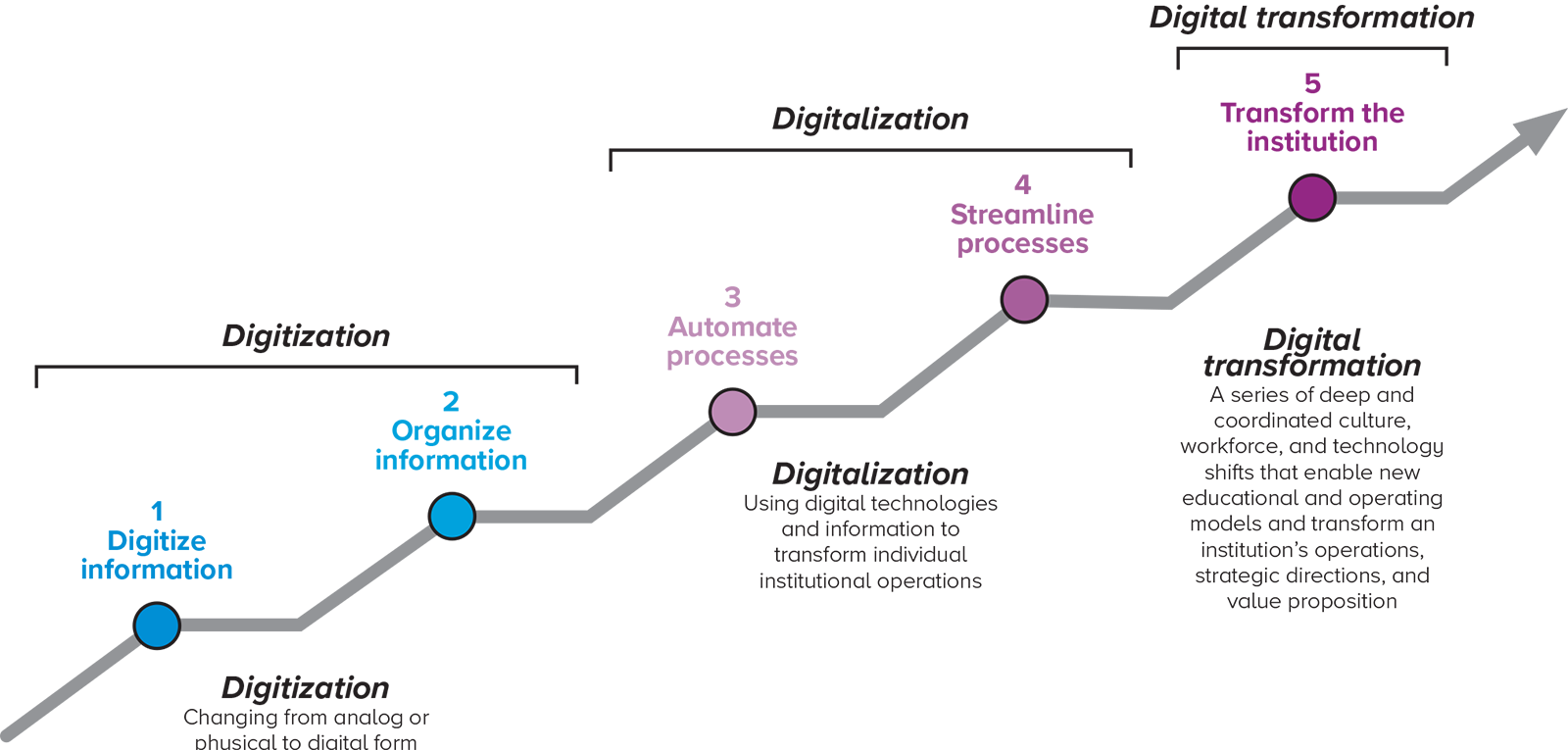
Digital transformation is focused on institutional transformation. Optimization or efficiency can be outcomes of digital transformation, but its real potential resides in addressing higher education's Grand Challenges. In August 2019, EDUCAUSE disseminated a survey to higher education IT leaders to explore their current experiences, attitudes, and practices related to digital transformation at their institutions. Specifically, we asked about seventeen potential benefits of digital transformation and whether those benefits would be minor, moderate, or major. More than three-quarters of respondents believed that all seventeen potential benefits produced by digital transformation would be at least moderate. Figure 3 maps the benefits to the four Grand Challenges and shows the percentage of survey respondents who believed that the benefit would be major.11
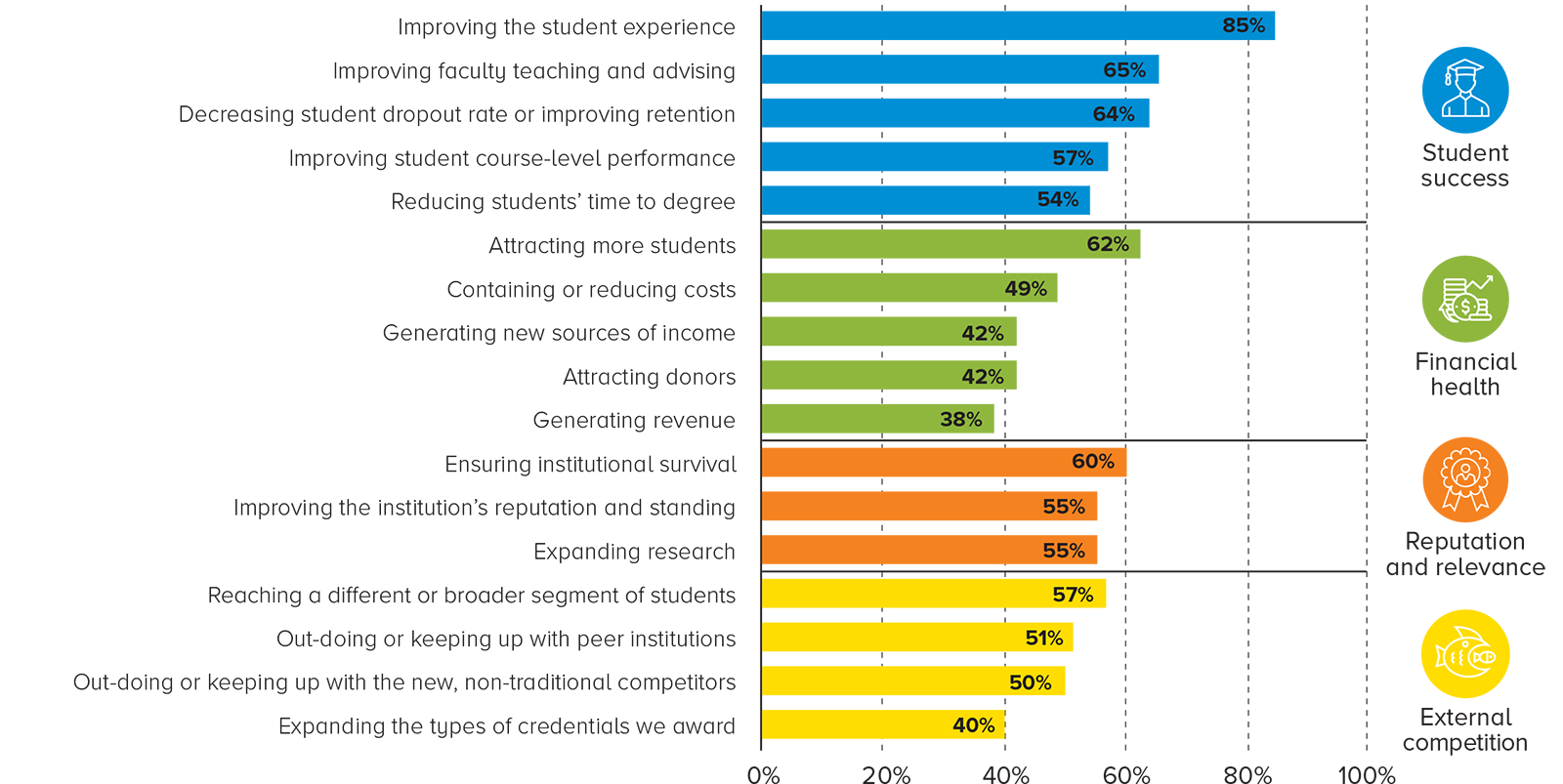
While only 13 percent of institutions in our study were already engaging in digital transformation, they may shed light on what other institutions will do.12 Today's Dx efforts are primarily focused on six benefits: improving the student experience; decreasing student drop-out rate or improving retention; improving faculty teaching and advising; improving student course-level performance; containing or reducing costs; and improving the institution's reputation and standing (see figure 4). Four of those six outcomes pertain to student success. The other grand challenges are not being neglected, though. Over half of institutions engaging in digital transformation are also focused on outcomes that can advance their reputation and relevance (improving the institution's reputation and standing), increase financial health (containing or reducing costs), and strengthen their position relative to external competition (reaching a different or broader segment of students).
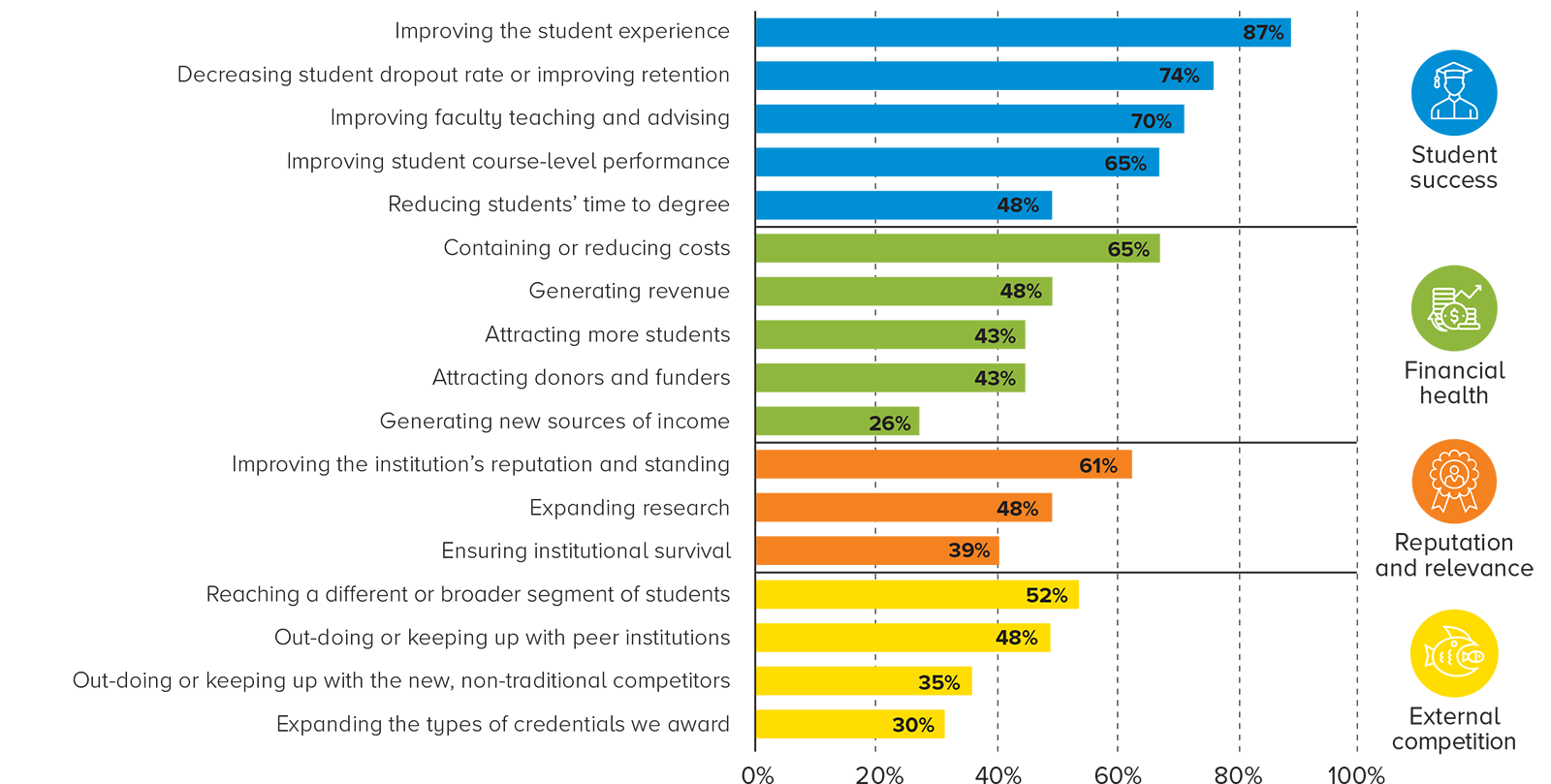
Digital transformation has clearly been gaining traction in higher education. Our Dx survey found that 67 percent of higher education IT leaders believe that digital transformation is more important now than it was two years ago and that 75 percent anticipate that it will be even more important two years from now. Our research also found that almost one-third (32%) of institutions are developing a Dx strategy and more than one-third (38%) are exploring it.13
The Pandemic: Higher Education's Fifth Grand Challenge
In March 2020, everything changed. The COVID-19 pandemic damaged endowments, closed campuses, required students and faculty to teach and learn from home environments that were not designed for that use, and threatened the existence of many higher education institutions. Some of the previously mentioned 2020 institutional leadership interviews took place in late March and April. In those conversations, presidents, provosts, chief business officers, and other leaders continued to highlight the strategic importance of enduring themes such as student success, enrollment, and partnerships. But they also raised new challenges:
- Crisis mitigation: "[We need] effective response to events over which we have little to no control."
- Health and safety: "The COVID-19 epidemic has created a sea change and caused us to reconsider a lot of assumptions. We're worried about the safety of our students and staff."
- Digital transformation: "We plan to reduce or eliminate low-priority services to create budget capacity for investments in digital transformation." "This whole episode has made us think about the unthinkable. I thought we were ready, but I think this is going to happen again in our lifetime. I'm thinking about worst-case scenarios and how technology will help us."
With COVID-19 both comprehensively and significantly affecting all of higher education, we have identified it as a fifth Grand Challenge (see figure 5).
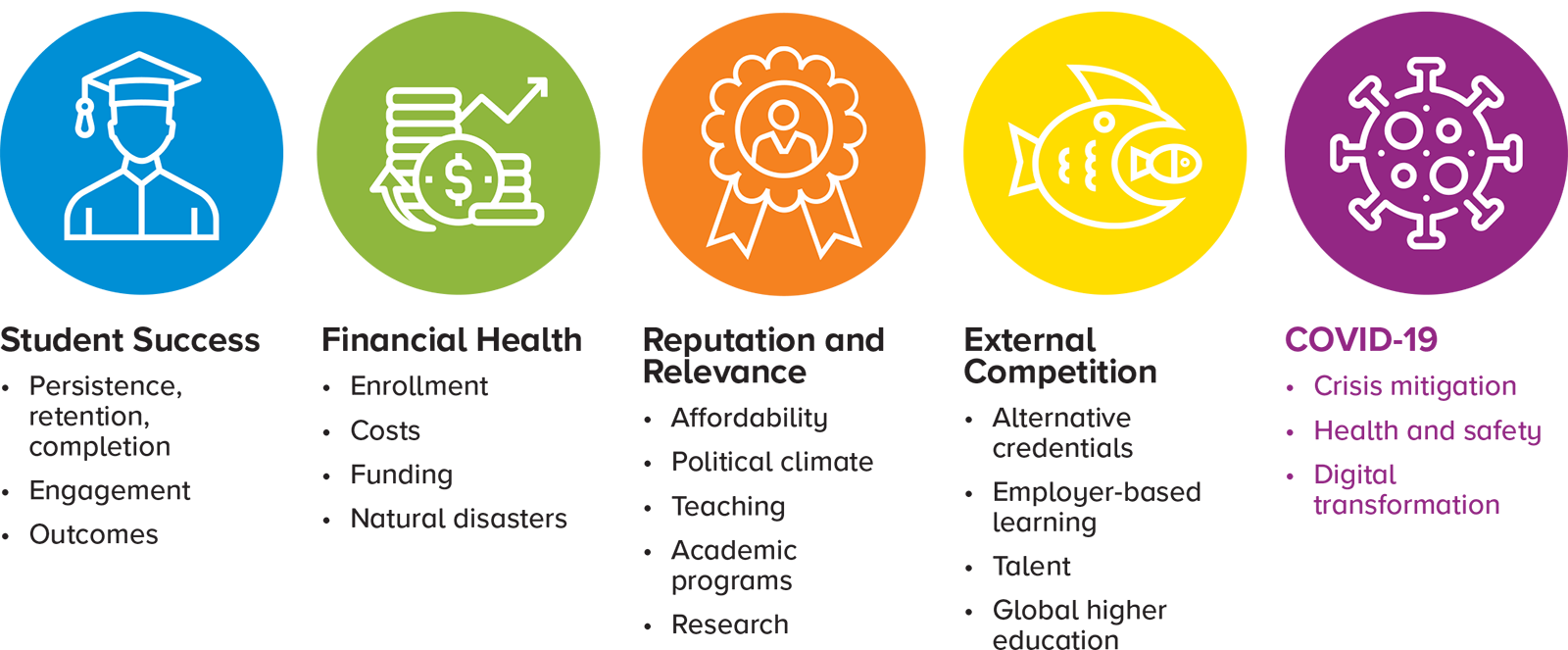
Conclusion
Higher education's Grand Challenges are pervasive and likely to remain with us, even as the pandemic upends everything. Although the pandemic has certainly changed life as we know it and has disrupted all industries, its long-term impact may be characterized less by what it has destroyed and more by what it has accelerated—namely, trends that were already underway. The business models of higher education have become even more precarious, online teaching and learning are suddenly a core competency for all institutions, and remote working has become a widely viable workforce option.
We think a Grand Strategy can help colleges and universities translate Grand Challenges into comprehensive yet targeted initiatives. Grand Challenges focus the institution on what outcomes need to be achieved. A Grand Strategy focuses the institution on how to achieve those outcomes. A Grand Strategy can help an institution identify the trade-offs it is willing to make and align its constituents in the desired direction. As higher education enters a period of major financial constraints, institutions could benefit from an approach that enables them to best utilize severely limited resources for a shared approach to achieving identified outcomes.
Digital transformation can fuel the Grand Strategy. EDUCAUSE has identified a set of "Dx signals" that can supply an institution with behaviors and actions to help operationalize its Grand Strategy.14 Whether an institution's Grand Strategy is focused on remaining viable or on creating innovative differentiation or on scaling up, digital transformation can help shift its culture, its workforce, and its technologies in order to address the five Grand Challenges. Respondents to an EDUCAUSE QuickPoll conducted in April 2020 reported new openness to digital transformation at their institutions:
- "Digital transformation is no longer considered 'impossible.'"
- "There is high interest in all aspects of digital transformation, using learning data and analytics for student success and widespread adoption of technologies to support student success."
- "There is a certain sense of optimism coupled with positive attitudes about digital transformation and innovation for teaching and learning—and many other things."
- "We are moving forward with digital transformation at a greater pace and with much less resistance."15
Respondents also described the speed at which digital transformation is beginning to happen:
- "The move to digital has been monumental. We have achieved more change on these fronts over the last six weeks than we have over the last two years. It has enabled people to change, and the outcome is a new path forward."
- "We have made thirty years of telehealth change in thirty days, allowing better patient access and better [less] physician/faculty burn-out."16
A May 2020 QuickPoll found that almost half (47%) of respondents' institutions are focusing on digital transformation as a way to reduce institutional costs.17
The benefits of digital transformation during the pandemic exceed simply moving missions and operations online. Digital transformation entails fundamental shifts in an institution's culture and workforce, as well as in the technologies it adopts. Digital transformation requires a culture that values flexibility and agility, has shifted from risk aversion to risk management, adjusts strategy in response to changing circumstances and new opportunities, is adept at change management, and prioritizes cross-organizational alignment and collaboration over siloed goals and autonomous lines of business. The pandemic has forced these culture shifts on colleges and universities, making possible new ways of thinking, working, and leading—ways that until now had seemed unlikely to ever happen at many higher education institutions. Of the many changes that colleges and universities made with astonishing speed this spring, it was the culture changes that were the most astounding and perhaps the most profound.
This pandemic may break higher education. Yet it may also remake it, by forcing shifts that seemed unimaginable just a few months ago. The result may be a more flexible, truly collaborative institution that is open to change and capable of taking strategic risks, an institution with a digitally fluent and inclusive workforce, an institution whose business and funding models acknowledge the continually evolving nature of technology, and an institution that sees the potential of emerging technologies to advance education, research, and student success. These are all components of, and part of the journey toward, digital transformation.
We must make choices, take risks, and act. Today's world demands that we move from deliberation and debate to rapid and responsible action. But to avoid devolving into mere dithering, our actions must be guided by visions of both the "what" and the "how."
We live in difficult times, and we must live up to those times. As our hobbit Frodo despaired to the wizard Gandalf, "I wish it need not have happened in my time." Gandalf replied: "So do I . . . and so do all who live to see such times. But that is not for them to decide. All we have to decide is what to do with the time that is given us."18
Notes
- J.R.R. Tolkien, The Lord of the Rings, 3 vols. (London: Allen & Unwin, 1954–55), vol. 2, The Two Towers. ↩
- Executive Office of the President, Office of Science and Technology Policy, "A Research and Development Strategy for High Performance Computing," November 20, 1987. ↩
- Brian Hawkins, "The EDUCAUSE 'Grand Challenges' Initiative," EDUCAUSE Annual Conference, Dallas, TX, October 10, 2006; Freeman A Hrabowski III, "A President's Perspective on EDUCAUSE's 'Grand Challenges,'" EDUCAUSE Review 42, no. 4 (July/August 2007). ↩
- The 2020 interviews were conducted with leaders of higher education institutions represented by the EDUCAUSE 2021 IT Issues Panel. They helped inform the 2021 Top 10 IT Issues (forthcoming in October 2020) and are unpublished. The 2019 interviews were referenced in Susan Grajek and the 2019–2020 EDUCAUSE IT Issues Panel, "Top 10 IT Issues, 2020: The Drive to Digital Transformation Begins," EDUCAUSE Review Special Report, January 27, 2020. ↩
- "25 Years of Declining State Support for Public Colleges," Chronicle of Higher Education, March 3, 2014. ↩
- Robert D. Atkinson and Caleb Foote, "U.S. Funding for University Research Continues to Slide," Information Technology and Innovation Foundation, October 19, 2019. ↩
- James Goldgeier and Jeremi Suri, "Revitalizing the U.S. National Security Strategy," Washington Quarterly 38, no. 4 (2015). ↩
- Rebecca Friedman Lissner, "What Is Grand Strategy? Sweeping a Conceptual Minefield," Texas National Security Review 2, no. 1 (November 2018). ↩
- "Grand Strategies," Business Jargons (website), accessed June 29, 2020; Martin Reeves, Knut Haanaes, and Janmejaya Sinha, "Navigating the Dozens of Different Strategy Options," Harvard Business Review, June 24, 2015. ↩
- Malcolm Brown, Betsy Reinitz, and Karen Wetzel, "Digital Transformation Signals: Is Your Institution on the Journey?" EDUCAUSE Review, May 12, 2020; D. Christopher Brooks and Mark McCormack, Driving Digital Transformation in Higher Education, research report (Louisville, CO: EDUCAUSE, June 2020). ↩
- Brooks and McCormack, Driving Digital Transformation in Higher Education. ↩
- Ibid. ↩
- Ibid. ↩
- Brown, Reinitz, and Wetzel, "Digital Transformation Signals." ↩
- Unpublished survey respondents from QuickPoll conducted for Susan Grajek, "EDUCAUSE COVID-19 QuickPoll Results: The Technology Workforce," Data Bytes (blog), EDUCAUSE Review, April 24, 2020. ↩
- Ibid. ↩
- Susan Grajek, "EDUCAUSE COVID-19 QuickPoll Results: IT Budgets, 2020–2021," Data Bytes (blog), EDUCAUSE Review, May 6, 2020. ↩
- Tolkien, The Lord of the Rings, vol. 1, The Fellowship of the Ring. ↩
Susan Grajek is Vice President, Communities and Research, for EDUCAUSE.
D. Christopher Brooks is Director of Research for EDUCAUSE.
EDUCAUSE Review 55, no. 3 (2020)
© 2020 Susan Grajek and D. Christopher Brooks. The text of this article is licensed under the Creative Commons Attribution-NonCommercial-NoDerivatives 4.0 International License.
